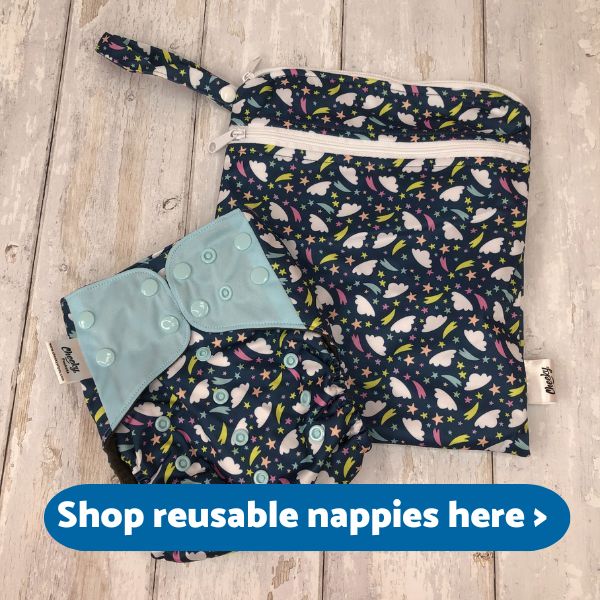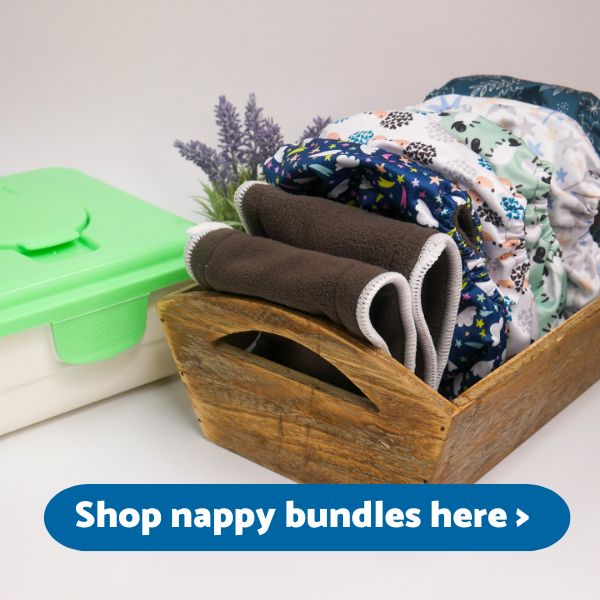Why Your Reusable Nappies are Leaking (And How to Stop It)7 March 2024 All nappies leak sometimes, whether they are disposable or reusable. Reusable cloth nappies have both advantages and disadvantages over disposable nappies. We are all aware of the climate crisis and our need to reduce waste. Limiting the single use items used for our babies is a great starting place. It is important that the washable nappies you choose work well for you and don't cause you more effort by leaking. We will help you to figure out why you might get leaks and how to prevent them. "Love these nappies - they fit well and provide good protection and coverage, and are very comfy for baby. Customer service is also top notch and they will go out of their way to help you. I've been really impressed and happy with these, I've tried probably no less than 10 other types of nappies and these are the winners of them all and my go to." Lina Jan '24 Trustpilot There are a few reasons why your reusable nappies are leaking, including - - Low Absorbency Level
- Poor Fit
- Infrequent Changes
- Damage
- Poor Routine
- Compression
- Flooding
If your reusable nappy leak is down to absorbency the absorbent parts of the nappy will be completely soaked. The nappy is full and needs to be changed sooner or have more absorbency added. Most nappies are sold with enough absorbency for a newborn but once babies tummies start to grow and they can feed in larger amounts they then pee larger volumes. Your options are to change regularly or add extra inserts to boost the nappies absorbency. This is hard with All In One and All In Two nappies so opt for pockets or fitteds. You will know if your leak is due to poor fit if you have gaps at the thigh which leads to leaks, however tummy gaps are fine. It can be tricky to get a good nappy fit in cloth. But it gets easier with practice. Be sure your baby is within the weight range for the nappy as you will get leaks if it is too big or too small. Make sure the nappy is fully contained in the nappy wrap or pee / poo will leak through onto babies clothes. Liners - make sure fleece liners are contained and not sticking out, disposable liners can slow newborn poop absorption, make sure liners are inside the double gusset - these are poo catching channels! Most washable nappies need changing every 3-4 hours. If cloth nappies are leaking sooner than 3 hours consider adding absorbency. Night nappies need to be more absorbent so choose a fitted nappy and wrap instead of a pocket or AIO. Frequent changes during the day is hygienic and keeps baby fresh and comfortable. 
If there are isolated wet patches on the outside of a waterproof nappy or wrap you can assume the PUL has been damaged. You might see tiny holes in the clingfilm like material inside or even bubbles and separation layers. Sometimes they can be resealed by a low tumble dry. Fabric softeners coat fibres, tumble drying, heated airers and radiators can melt PUL, ammonia causing balding, detergent build up! Avoid all of these to keep your nappies working perfectly. If you use creams on baby make sure they don't coat the inside of your nappies and stop absorption. Nappy rashes aren't common with cloth babies but our coconut oil is cloth safe and makes a great barrier cream. Nappies should be prewashed before first use 3 or 4 times to reach their full absorbency. They don't need to be washed at 60 degrees, a cold wash will do for these prewashes. If nappies are left too long between washes or are not washed on long enough cycles they can build up ammonia and start to smell, and can even cause soreness and rashes on your babies bottom. Too little or too much detergent can also cause problems. If nappies are used away from home make sure they are dealt with as soon as you get home and they don't get left in a wetbag after nursery.
If the nappy is squashed tight against baby by tight clothes it won't have space to absorb urine, like a sponge fluid will squeeze out. You can use vest extenders to increase space for the washable nappy or size up on baby clothes. You will know if the leaks are due to compression if they are sudden and the rest of the nappy is dry except for one place. You will know if your leaks are due to flooding if the inserts are soaked in one area only. Newborns have tiny bladders and pee tiny amounts, toddlers can hold their bladders and release in a flood. Sometimes the fabric of the nappy can't keep up and liquid will make its way to the leg elastics and onto clothes. Changing inserts in a pocket nappy or boosters in other nappies for a quick absorbing insert folded in the area urine hits first - in the front for boys and underneath for girls -with a heavy absorber behind will counter this. Opt for bamboo or hemp under microfibre. 
Here's how to stop your reusable nappies leaking: - Achieve a Proper Fit
- Use Inserts or Boosters
- Regular Changes
- Proper storage and washing
The cotton or bamboo nappy should be placed low underneath baby - think builders bum. Pinch and pull the crotch of the nappy up between babies legs and into the pant line. Lift the wing up toward the opposite armpit, and secure the hip poppers then waist poppers. You can follow our step buy step guide here to get a great fit. Measurements that affect fit - - Rise - the poppers on the front panel of the nappy or wrap set the height on babies body and determines the leg round size
- Hip poppers - stops wings drooping and tightens the leg round
- Leg round - make sure this is snug to avoid leaks, double gussets work best
- Waist - leave space (two fingers) for babies tum
In modern cloth nappies fabric layers replace the chemical gel absorbers you'd have in disposables. New washable inserts have smooth unplumped fibres and need washing in the washing machine 3 to 4 times to increase absorbency, more boosters can be added for heavy wetters. Match the number of inserts to the amount of time you want the nappy to last (more for overnight) don't over boost or you'll get a gap at the leg or risk compression leaks. Different boosters have different qualities: - Microfibre - fastest absorbing lowest capacity - great for soaking up liquid quickly but a bit like a sponge so doesn't hold the fluid well
- Cotton - fast absorbing moderate capacity - absorbent but more bulky than bamboo
- Bamboo - natural fibre, slower absorbing high capacity - slim in comparison to absorbency level, less hardwearing fabric
- Hemp - slowest absorbing highest capacity - super slim and absorbent, but most expensive, least hardwearing
It is important to change nappies regularly, in particular if your child is a heavy wetter. Change every 2-3 hours during the day if you have a heavy wetter and always as soon as baby poos. Wraps can often be reused if the stay dry layer can be wiped dry. Change overnight nappy as soon as your little one wakes up. 
A high quality washing and care routine will keep your nappies working well, smelling fresh and will make your life easier. Current school of thought is to store nappies in airy containers so that smells and ammonia can't build up. There is no need to store washable diapers in water filled buckets anymore. You can follow our washing and care guide. If this article was useful for you, you might want to read - What do I need to use reusable nappies? Beginners guide to reusable nappies How many reusable nappies do I need? If you need any more guidance, drop the team a line or come and find me on the online chat UK time 10am-2pm. We use the products everyday and LOVE to chat nappies, poo and wee, all day long, nothing is TMI and we all love to overshare based on our own experiences... About the Author: Kirstin is part of the Customer Experience team at Cheeky Wipes, which since 2008 has been selling the original reusable wipes kit. She is mum to three kids and loves the forest, the sea and the hills! Along with the rest of our crack team, she spends most days talking about poo, pee and periods and loves a chance to overshare. Cheeky wipes were recognised with a Queens Award for Enterprise in Sustainable Development in 2021, celebrating their hard work over the last 13 years. |